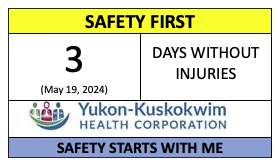The river ice has broken up and summer is just around the corner! This is a good time to review some measures you can take to ensure you are ready for and continue to stay safe during this boating season! Boating is a way of life in the Yukon-Kuskokwim Delta, whether you are traveling, fishing, logging or just going for a boat ride, tubing, canoeing, rafting, kayaking, swimming and other activities in the water. Be prepared every time you go out.
Life jackets save lives!
Buckle up! Make sure you and your loved ones wear a properly-fitting life jacket when you are on the water. Before you head out to the river, do a quick fit-check on your life jacket!
- Look at the label and make sure the jacket is a proper fit for your size and weight.
- Make sure all the buckles on the jacket are properly fastened.
- Hold your arms straight up over your head and ask a friend to grasp the tops of the arm openings and gently pull up. There should not be any excess room above the openings and the jacket should not ride up over your chin or face.
Prepare for Your boat trip by performing all your checks!
Sobriety check – exercise good judgment. Drugs and alcohol affect judgment, vision, balance, coordination and reaction time. Don’t operate a boat under the influence of alcohol or drugs!
Check the weather forecast and river conditions. Learn your limits for operating in unfavorable circumstances. If you notice storm clouds, a sudden drop in temperature or wind speed increasing, play it safe and get off the water.
Check the tide chart. Tides and currents affect water conditions, so you should be mindful of where you can safely travel, beach or anchor. Do your research before a trip, and know what type of conditions to expect.
Check that your equipment is in good working order. Find or create a pre-departure checklist to ensure you have everything you need in your boat.
This could include:
- Tool kit
- First-aid kit
- Extra fuel and parts
- Towels and blankets
- Fire starting tools
- Flares and flashing lights
- An extra set of clothes in case you get wet
- Sunscreen and bug spray
- Plenty of drinking water.
Leave a float plan with a reliable person. Once you return home safely, or you change any of your plans, notify your contact.
Be aware of these hazards when boating on the river:
- Currents are the strongest over the deepest part of the channel. Currents are stronger during and immediately following rain; water levels may also rise dramatically during this period. This affects the boats speed and direction. It may overpower the boat. Upstream travel takes more fuel and time. Strong winds against currents and incoming tides can create turbulence.
- Sandbars can form on the inside of a bend, where two rivers join, near river mouths, and where water flow changes from rapid to slow. Sandbars, along with floating or submerged debris and rocks can cause any of the following: grounding, capsizing, being thrown from the boat, and damage to the lower engine, prop, and hull.
- Strainers, also known as sweepers, are obstructions in the water that allow water to pass through (e.g., trees, branches, and fences.) but are known hazards for boaters. These may cause boats to capsize or damage to the lower engine, prop, and hull.
- “Widow makers” are tree trunks extending over the river, near or at high water due to a collapsing riverbank. Be prepared for trees to fall from a bank in front of you, especially when the current is behind you. Widow makers can sweep people out of the boat, hold and trap the boat and/or people, and capsize the boat.
- Watch for floating logs and other debris, especially after floodwaters recede following spring break-up.
- Maintain control of the boat at all times while operating it. Drive at an appropriate speed, enough to maintain steerage, but slow enough to see ahead and respond to unexpected situations. Look ahead and plan your route. Take action in sufficient time, currents can sweep you into hazards. Expect the unexpected, any and all possible hazards.
Life jackets save lives! We can’t say it enough.
If you find yourself in an emergency situation, stay calm. Do not panic. Recognize you are in an emergency. Make sure everyone is ok. Call for help. Stay near the boat. It’s easier for rescuers to find the boat first. If you must leave the boat, find something that will help make a big contrasting signal for rescues to find. Wearing a life jacket will help you swim to shore and wearing high-visibility gear will help others find and rescue you.
YKHC partners with the State of Alaska and regional tribes every year and provides hundreds of “Kids Don’t Float” life jackets for our communities. Kids Don’t Float is a statewide injury prevention program that was developed to address Alaska’s high child and youth drowning rate. The program is free and it provides a life jacket loaner board with signage and life jackets that can be borrowed by boaters (at no cost). If your village does not have a loaner board and your tribe is interested in being a local sponsor, please contact YKHC’s Injury Prevention department at 907-543-6420.
YKHC also sells a variety of life jackets, float coats and other safety equipment at the Safety Store, located near the cafeteria in the Bethel hospital. If you are interested in purchasing a new life jacket or other safety equipment, but you are not in Bethel, you can contact our Safety Store at 907-543-6556 or email SafetyStore@ykhc.org . Shipping is free to all YK villages.
Have a safe and enjoyable boating season!
